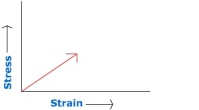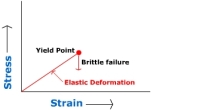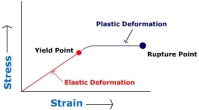Digging Deeper into the Behavior of Rock MaterialRocks behave in a variety of ways when stress is imposed on them. The relationship between stress and deformation is shown in stress-strain diagrams like those below. The reaction of rock material to an imposed stress depends on the temperature and pressure conditions. As stress is imposed on rock it starts to deform up to its yield point. Before it gets to the yield point, the rock will undergo elastic deformation (Figure 15.20). Like a rubber band, if the stress is released before reaching the yield point, the rock material will return to its original shape. However, under low temperature and pressure conditions, once the rock reaches its yield point it will break, called brittle failure (Figure 15.21). Brittle failure may occur if stress is imposed suddenly as well. |
||
|
Figure DD 15.1 |
Figure DD 15.2 Low temperature and pressure conditions, or sudden stress |
Figure DD 15.3 High pressure and temperature conditions |
|
Upon reaching the yield point under high pressure and temperature conditions, the rock may undergo plastic deformation (Figure 15.22). In this case, once the rock changes shape and if stress is released, it will not return to its original form. During plastic deformation mineral bonds adjust to the stress by breaking, moving about, and then reforming. Once it reaches its rupture point, the material will break. |
||


